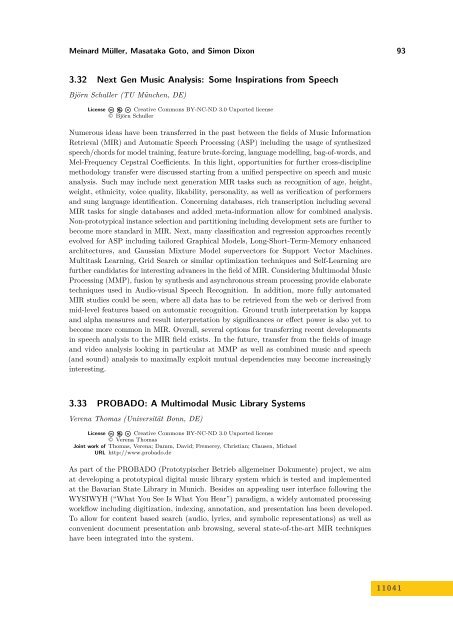Volume 1, Issue 1, January 2011 - DROPS - Schloss Dagstuhl
Volume 1, Issue 1, January 2011 - DROPS - Schloss Dagstuhl
Volume 1, Issue 1, January 2011 - DROPS - Schloss Dagstuhl
You also want an ePaper? Increase the reach of your titles
YUMPU automatically turns print PDFs into web optimized ePapers that Google loves.
Meinard Müller, Masataka Goto, and Simon Dixon 93<br />
3.32 Next Gen Music Analysis: Some Inspirations from Speech<br />
Björn Schuller (TU München, DE)<br />
License Creative Commons BY-NC-ND 3.0 Unported license<br />
© Björn Schuller<br />
Numerous ideas have been transferred in the past between the fields of Music Information<br />
Retrieval (MIR) and Automatic Speech Processing (ASP) including the usage of synthesized<br />
speech/chords for model training, feature brute-forcing, language modelling, bag-of-words, and<br />
Mel-Frequency Cepstral Coefficients. In this light, opportunities for further cross-discipline<br />
methodology transfer were discussed starting from a unified perspective on speech and music<br />
analysis. Such may include next generation MIR tasks such as recognition of age, height,<br />
weight, ethnicity, voice quality, likability, personality, as well as verification of performers<br />
and sung language identification. Concerning databases, rich transcription including several<br />
MIR tasks for single databases and added meta-information allow for combined analysis.<br />
Non-prototypical instance selection and partitioning including development sets are further to<br />
become more standard in MIR. Next, many classification and regression approaches recently<br />
evolved for ASP including tailored Graphical Models, Long-Short-Term-Memory enhanced<br />
architectures, and Gaussian Mixture Model supervectors for Support Vector Machines.<br />
Multitask Learning, Grid Search or similar optimization techniques and Self-Learning are<br />
further candidates for interesting advances in the field of MIR. Considering Multimodal Music<br />
Processing (MMP), fusion by synthesis and asynchronous stream processing provide elaborate<br />
techniques used in Audio-visual Speech Recognition. In addition, more fully automated<br />
MIR studies could be seen, where all data has to be retrieved from the web or derived from<br />
mid-level features based on automatic recognition. Ground truth interpretation by kappa<br />
and alpha measures and result interpretation by significances or effect power is also yet to<br />
become more common in MIR. Overall, several options for transferring recent developments<br />
in speech analysis to the MIR field exists. In the future, transfer from the fields of image<br />
and video analysis looking in particular at MMP as well as combined music and speech<br />
(and sound) analysis to maximally exploit mutual dependencies may become increasingly<br />
interesting.<br />
3.33 PROBADO: A Multimodal Music Library Systems<br />
Verena Thomas (Universität Bonn, DE)<br />
License Creative Commons BY-NC-ND 3.0 Unported license<br />
© Verena Thomas<br />
Joint work of Thomas, Verena; Damm, David; Fremerey, Christian; Clausen, Michael<br />
URL http://www.probado.de<br />
As part of the PROBADO (Prototypischer Betrieb allgemeiner Dokumente) project, we aim<br />
at developing a prototypical digital music library system which is tested and implemented<br />
at the Bavarian State Library in Munich. Besides an appealing user interface following the<br />
WYSIWYH (“What You See Is What You Hear”) paradigm, a widely automated processing<br />
workflow including digitization, indexing, annotation, and presentation has been developed.<br />
To allow for content based search (audio, lyrics, and symbolic representations) as well as<br />
convenient document presentation anb browsing, several state-of-the-art MIR techniques<br />
have been integrated into the system.<br />
1 1 0 4 1













